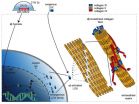(Press-News.org) BOSTON — Findings published in the Archives of Physical Medicine and Rehabilitation show that imperceptible vibratory stimulation applied to the soles of the feet improved balance by reducing postural sway and gait variability in elderly study participants. The vibratory stimulation is delivered by a urethane foam insole with embedded piezoelectric actuators, which generates the mechanical stimulation. The study was conducted by researchers from the Institute for Aging Research (IFAR) at Hebrew SeniorLife, Beth Israel Deaconess Medical Center, the Wyss Institute for Biologically Inspired Engineering at Harvard University, and Harvard Medical School, all of Boston, Massachusetts; and Merck Sharpe and Dohme (MSD) Consumer Care, Inc., of Memphis, Tennessee.
These findings are significant because poor balance and an irregular gait are directly related to fall risk. Falls are the leading cause of death from injury among seniors. Risk increases with age and even the fear of falling can reduce quality of life.
1 in 3 seniors falls each year, and 25% of those who fall suffer moderate to severe injuries, such as hip fractures.
Only 25% of hip fracture patients make a full recovery; 40% require nursing home care; and nearly 25% die within 12 months.
By 2020, the annual direct and indirect cost of fall injuries is expected to reach nearly $55 billion.
"Although loss of sensation in the feet is a common problem among elderly people that can impair balance and gait and result in falls, there are currently no interventions available that can reverse sensory impairments and prevent these dangerous consequences," said study lead author Lewis Lipsitz, M.D., Director of the Institute for Aging Research. "We were very excited to discover that small amounts of vibratory noise applied to the soles of the feet may be able to do just that."
This study follows earlier research that looked at how the physical principle of stochastic resonance could be applied to mitigate deficits in the human somatosensory systems that develop due to disease, injury, or age. The somatosensory system informs us about objects in our external environment through touch. Receptors are distributed all over the body and different types of receptors respond to many different kinds of stimuli. Stochastic resonance (SR) is a phenomenon whereby the detectability of weak signals in certain types of systems can be improved through the careful addition of low-amplitude white noise. This may seem paradoxical because noise is usually thought to reduce our ability to detect a signal, for example, we may have difficulty hearing someone talking to us at a noisy party, but the principle of SR states in fact that a certain low level of white noise can actually enhance signal detection.
Earlier studies, by Wyss Institute Core Faculty member James Collins, Ph.D., a Professor of Medicine and Biomedical Engineering at Boston University, have shown that imperceptible vibratory noise applied to the feet can improve balance in healthy young and elderly subjects and patients with diabetic neuropathy and stroke. IFAR researchers showed that this approach could significantly reduce the stride-, stance- and swing-time variability exhibited in walking by elderly people with a history of falling down. However, the devices that delivered the stimulation in the earlier IFAR studies required large energy sources, limiting their practical and portable application..
Following the experiments with these limiting early devices, the device was completely redesigned by Wyss Institute researchers to use piezoelectric actuators to improve portability and energy efficiency. Piezoelectric actuators convert electrical energy into mechanical signals, such as pressure or movement of some kind. These actuators, inserted into a typical insole using a standard manufacturing process, are driven by a small encasement on the tongue of the shoe that contains a tiny circuit and rechargeable battery.
The vibrating insole study enrolled 12 elderly volunteers in good health, between the ages of 65 and 90 years old. Two piezoelectric actuators to deliver the vibratory stimulation were placed in the medial arch region of commonly-available insoles. Then, participants underwent a battery of tests that measured their balance and assessed their gait. They were also given a timed "Get Up and Go" test, which measured how long it took participants to stand up from sitting, walk three meters, turn around, walk back, and sit down again.
Results of this study demonstrated that the vibratory insoles significantly improved performance on the timed "Get Up and Go" test, reduced the range of postural sway, and reduced the variability of walking. Also, the effect of the insoles persisted throughout the course of a day.
INFORMATION:
This study was supported by Merck Sharpe and Dohme (MSD) Consumer Care, Inc., Memphis, Tennessee, the National Institute on Aging, Bethesda, Maryland, and the Wyss Institute for Biologically Inspired Engineering at Harvard University, Boston, Massachusetts.
About the Institute for Aging Research
Scientists at the Institute for Aging Research seek to transform the human experience of aging by conducting research that will ensure a life of health, dignity and productivity into advanced age. The Institute carries out rigorous studies that discover the mechanisms of age-related disease and disability; lead to the prevention, treatment and cure of disease; advance the standard of care for older people; and inform public decision-making.
About Hebrew SeniorLife
Hebrew SeniorLife, an affiliate of Harvard Medical School, is a national senior services leader uniquely dedicated to rethinking, researching and redefining the possibilities of aging. Based in Boston, the non-profit, non-sectarian organization has provided communities and health care for seniors, research into aging, and education for geriatric care providers since 1903. For more information about Hebrew SeniorLife, visit http://www.hebrewseniorlife.org, follow us on Twitter @H_SeniorLife, like us on Facebook or read our blog.
The Wyss Institute for Biologically Inspired Engineering at Harvard University uses Nature's design principles to develop bioinspired materials and devices that will transform medicine and create a more sustainable world. Working as an alliance among all of Harvard's Schools, and in partnership with Beth Israel Deaconess Medical Center, Brigham and Women's Hospital, Boston Children's Hospital, Dana Farber Cancer Institute, Massachusetts General Hospital, the University of Massachusetts Medical School, Spaulding Rehabilitation Hospital, Boston University, Tufts University, and Charité - Universitätsmedizin Berlin, and the University of Zurich, the Institute crosses disciplinary and institutional barriers to engage in high-risk research that leads to transformative technological breakthroughs. By emulating Nature's principles for self-organizing and self-regulating, Wyss researchers are developing innovative new engineering solutions for healthcare, energy, architecture, robotics, and manufacturing. These technologies are translated into commercial products and therapies through collaborations with clinical investigators, corporate alliances, and new start-ups.
A significant breakthrough in laser technology has been reported by the U.S. Department of Energy (DOE)'s Lawrence Berkeley National Laboratory (Berkeley Lab) and the University of California (UC) Berkeley. Scientists led by Xiang Zhang, a physicist with joint appointments at Berkeley Lab and UC Berkeley, have developed a unique microring laser cavity that can produce single-mode lasing even from a conventional multi-mode laser cavity. This ability to provide single-mode lasing on demand holds ramifications for a wide range of applications including optical metrology and ...
Lab-grown tissues could one day provide new treatments for injuries and damage to the joints, including articular cartilage, tendons and ligaments.
Cartilage, for example, is a hard material that caps the ends of bones and allows joints to work smoothly. UC Davis biomedical engineers, exploring ways to toughen up engineered cartilage and keep natural tissues strong outside the body, report new developments this week in the journal Proceedings of the National Academy of Sciences.
"The problem with engineered tissue is that the mechanical properties are far from those ...
Washington, DC—The Endocrine Society today issued a Clinical Practice Guideline (CPG) for the diagnosis and treatment of acromegaly, a rare condition caused by excess growth hormone in the blood.
The CPG, entitled "Acromegaly: An Endocrine Society Clinical Practice Guideline," appeared in the November 2014 issue of the Journal of Clinical Endocrinology and Metabolism (JCEM), a publication of the Endocrine Society.
Acromegaly is usually caused by a non-cancerous tumor in the pituitary gland. The tumor manufactures too much growth hormone and spurs the body to overproduce ...
Chicago, October 30, 2014—Analysis of data from an institutional patient registry on stereotactic body radiotherapy (SBRT) indicates excellent long-term, local control, 79 percent of tumors, for medically inoperable, early stage lung cancer patients treated with SBRT from 2003 to 2012, according to research presented today at the 2014 Chicago Multidisciplinary Symposium in Thoracic Oncology. The Symposium is sponsored by the American Society of Clinical Oncology (ASCO), the American Society for Radiation Oncology (ASTRO), the International Association for the Study ...
BUFFALO, N.Y. – You have to be at least 2 years old to be covered by U.S. dietary guidelines. For younger babies, no official U.S. guidance exists other than the general recommendation by national and international organizations that mothers exclusively breastfeed for at least the first six months.
So what do American babies eat?
That's the question that motivated researchers at the University at Buffalo School of Medicine and Biomedical Sciences to study the eating patterns of American infants at 6 months and 12 months old, critical ages for the development of ...
NOAA's GOES-West satellite captured an image of the birth of the Eastern Pacific Ocean's twenty-first tropical depression, located far south of Acapulco, Mexico.
NOAA's GOES-West satellite gathered infrared data on newborn Tropical Depression 21E (TD 21E) and that data was made into an image by NASA/NOAA's GOES Project at NASA's Goddard Space Flight Center in Greenbelt, Maryland. At 1200 UTC (9 a.m. EDT), the GOES-West image showed that thunderstorms circled the low-level center and extended northeast of the center indicating that southwesterly wind shear was affecting ...
Professor Elly Tanaka and her research group at the DFG Research Center for Regenerative Therapies Dresden - Cluster of Excellence at the TU Dresden (CRTD) demonstrated for the first time the in vitro growth of a piece of spinal cord in three dimensions from mouse embryonic stem cells. Correct spatial organization of motor neurons, interneurons and dorsal interneurons along the dorsal/ventral axis was observed.
This study has been published online by the American journal "Stem Cell Reports" on 30.10.2014.
For many years Elly Tanaka and her research group have been studying ...
As transistors get smaller, they also grow less reliable. Increasing their operating voltage can help, but that means a corresponding increase in power consumption.
With information technology consuming a steadily growing fraction of the world's energy supplies, some researchers and hardware manufacturers are exploring the possibility of simply letting chips botch the occasional computation. In many popular applications — video rendering, for instance — users probably wouldn't notice the difference, and it could significantly improve energy efficiency.
At ...
Global warming is altering the reproduction of plants and animals, notably accelerating the date when reproduction and other life processes occur. A study by the University of Uppsala (Sweden), including the participation of Spanish researcher Germán Orizaola, has discovered that some amphibians are capable of making their offspring grow at a faster rate if they have been born later due to the climate.
Over recent decades many organisms, both plants and animals, have experienced a notable advance in the date when many of their life processes (like reproduction, migration ...
Soon, many will turn back the hands of time as part of the twice-annual ritual of daylight savings time. That means remembering to change the alarm clock next to the bed, which will mean an extra hour of sleep before getting up in the morning.
But for some diabetics who use insulin pumps, Saleh Aldasouqi, associate professor of medicine at Michigan State University, suggests that remembering to change the time on this device should be the priority.
"Some diabetes patients who use insulin pumps may forget to change the clock that is found in these devices," said diabetes ...






